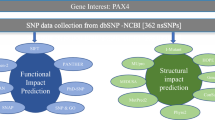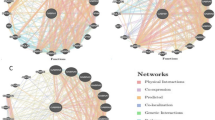Abstract
Histone modifications such as acetylation play a fundamental role in DNA packaging and genome regulation and HAT1 protein is involved in gene transcription, DNA repair, and chromatin assembly. Single nucleotide polymorphisms (SNPs) in the human HAT1 gene may be correlated with human diseases such as cancers, inflammatory, and neuropsychiatric diseases. Hence, identification of putative functional SNPs which affect structure and/or function of protein is important for understanding the molecular mechanisms of pathogenesis of diseases and discovery of potential therapeutic agents. In this study, numerous bioinformatics tools were used to determine the most damaging nsSNPs for the function and/or structure of HAT1 protein. In silico analysis was carried out by different algorithmic programs including SIFT, PolyPhen-2, PROVEAN, SNPs&GO, and PhD-SNP. Our study concludes that mutation of Leucine → Arginine at position 416 (rs199575205) is major deleterious mutation which may lead to damage of HAT1 protein. Analyis of HAT1 gene variants by computational tools is a first and comprehensive in silico study. Future in vitro and in vivo studies should include this nsSNP as main target for the development of therapeutics for diseases that are associated with this missense polymorphism.




Similar content being viewed by others
REFERENCES
Adzhubei, I., Jordan, D.M., and Sunyaev, S.R., Predicting functional effect of human UNIT 7.20 missense mutations using PolyPhen-2, Curr. Protoc. Hum. Genet., 2013, vol. 76, pp. 7.20.1–7.20.41. https://doi.org/10.1002/0471142905.hg0720s76
Annan, R.S. and Zappacosta, F., Protein posttranslational modifications: phosphorylation site analysis using mass spectrometry, Methods Biochem. Anal., 2005, vol. 45, pp. 85–106.
Arshad, M., Bhatti, A., and John, P., Identification and in silico analysis of functional SNPs of human TAGAP protein: a comprehensive study, PLoS One, 2018, vol. 13. e0188143. https://doi.org/10.1371/journal.pone.0188143
Ashkenazy, H., Abadi, S., Martz, E., Chay, O., Mayrose, I., Pupko, T., et al., ConSurf 2016: an improved methodology to estimate and visualize evolutionary conservation in macromolecules, Nucleic Acids Res., 2016, vol. 8, pp. W344–W350. https://doi.org/10.1093/nar/gkw408
Berezin, C., Glaser, F., Rosenberg, J., Paz, I., Pupko, T., Fariselli, P., et al., ConSeq: the identification of functionally and structurally important residues in protein sequences, Bioinformatics, 2004, vol. 20, pp. 1322–1324. https://doi.org/10.1093/bioinformatics/bth070
Bhagwat, M., Searching NCBI’s dbSNP database, Curr. Protoc. Bioinformatics, 2010, chapter: unit 1.19. https://doi.org/10.1002/0471250953.bi0119s32
Capriotti, E., Fariselli, P., and Casadio, R., I-Mutant2.0: predicting stability changes upon mutation from the protein sequence or structure, Nucleic Acids Res., 2005, vol. 33, pp. W306–W310. https://doi.org/10.1093/nar/gki375
Capriotti, E., Calabrase, R., Fariselli, P., Martelli, P.L., Altman, R.B., and Casadio, R., WS-SNPs&GO: a web server for predicting the deleterious effect of human protein variants using functional annotation, BMC Genomics, 2013, vol. 14, suppl. 3, p. S6.
Capriotti, E. and Fariselli, P., PhD-SNPg: a webserver and lightweight tool for scoring single nucleotide variants, Nucleic Acids Res., 2017, vol. 454, pp. W247–W252. https://doi.org/10.1093/nar/gkx369
Carugo, O. and Pongor, S., A normalized root-mean-square distance for comparing protein three-dimensional structures, Protein Sci., 200, vol. 110, pp. 1470–1473. https://doi.org/10.1110/ps.690101
Chen, R., Davydov, E.V., Sirota, M., and Butte, A.J., Non-synonymous and synonymous coding SNPs show similar likelihood and effect size of human disease association, PLoS One, 2010, vol. 5, art. e13574. https://doi.org/10.1371/journal.pone.0013574
Choi, Y. and Chan, A.P., PROVEAN web server: a tool to predict the functional effect of amino acid substitutions and indels, Bioinformatics, 2015, vol. 31, pp. 2745–2747. https://doi.org/10.1093/bioinformatics/btv195
Colovos, C. and Yeates, T., ERRAT: an empirical atom-based method for validating protein structures, Protein Sci., 1993, vol. 2, pp. 1511–1519.
Deng, W., Wang, C., Zhang, Y., Xu, Y., Zhang, S., Liu, X., et al., GPS-PAIL: prediction of lysine acetyltransferase-specific modification sites from protein sequences, Sci. Rep., 2016, vol. 6, p. 39787.
Du, K., Sharma, M., and Lukacs, G.L., The DeltaF508 cystic fibrosis mutation impairs domain-domain interactions and arrests post-translational folding of CFTR, Nat. Struct. Mol. Biol., 2005, vol. 12, pp. 17–25. https://doi.org/10.1038/nsmb882
Gruber, J.J., Geller, B., Lipchik, A.M., Chen, J., Salahudeen, A.A., and Ram, A.N., HAT1 drives a gene-metabolite circuit that links nutrient metabolism to histone production, bioRxiv, 2019. https://doi.org/10.1101/664615
Hu, Z., Zhou, J., Jiang, J., Yuan, J., Zhang, Y., and Wei, X., Genomic characterization of genes encoding histone acetylation modulator proteins identifies therapeutic targets for cancer treatment, Nat. Commun., 2019, vol. 10, p. 733. https://doi.org/10.1038/s41467-019-08554-x
Jin, X., Tian, S., and Li, P., Histone acetyltransferase 1 promotes cell proliferation and induces cisplatin resistance in hepatocellular carcinoma, Oncol. Res., 2017, vol. 25, pp. 939–946. https://doi.org/10.3727/096504016X14809827856524
Kaur, T., Khakur, T., Singh, J., Kamboj, S.S., and Kaur, M., Identification of functional SNPs in human LGALS3 gene by in silico analyses, Egypt J. Med. Hum., 2017, vol. 18, pp. 321–328. https://doi.org/10.1016/j.ejmhg.2017.02.001
Kelley, L.A., Mezulis, S., Yates, C.M., Wass, M.N., and Sternberg, M.J., The Phyre2 web portal for protein modeling, prediction and analysis, Nat. Protoc., 2015, vol. 10, pp. 845–858. https://doi.org/10.1038/nprot.2015.053
Kucukkal, T.G., Petukh, M., Li, L., and Alexov, E., Structural and physico- chemical effects of disease and non-disease nsSNPs on proteins, Curr. Opin. Struct. Biol., 2015, vol. 32, pp. 18–24. https://doi.org/10.1016/j.sbi.2015.01.003
Kumar, P., Henikoff, S., and Ng, P.C., Predicting the effects of coding non-synonymous variants on protein function using the SIFT algorithm, Nat. Protoc., 2009, vol. 4, pp. 1073–1081. https://doi.org/10.1038/nprot.2009.86
Lee, J., Son, M.J., Son, C.Y., Jeong, G.H., Lee, K.H., and Lee, K.S., Genetic variation and autism: a field synopsis and systematic meta-analysis, Brain Sci., 2020, vol. 10, p. 692. https://doi.org/10.3390/brainsci10100692
Li, B., Krishnan, V.G., Mort, M.E., Xin, F., Kamati, K.K., Cooper, D.N., et al., Automated inference of molecular mechanisms of disease from amino acid substitutions, Bioinformatics, 2009, vol. 25, pp. 2744–2750. https://doi.org/10.1093/bioinformatics/btp528
Mayer, S., Rüdiger, S., Ang, H.C., Joerger, A.C., and Fersht, A.R., Correlation of levels of folded recombinant p53 in Escherichia coli with thermodynamic stability in vitro, J. Mol. Biol., 2007, vol. 372, pp. 268–276. https://doi.org/10.1016/j.jmb.2007.06.044
Miller, M.P. and Kumar, S., Understanding human disease mutations through the use of interspecific genetic variation, Hum. Mol. Genet., 2001, vol. 10, pp. 2319–2328. https://doi.org/10.1093/hmg/10.21.2319
Nakamura, N., Ubiquitin system, Int. J. Mol. Sci., 2018, vol. 19, p. 1080. https://doi.org/10.3390/ijms19041080
Osman, M.M., Khalifa, A.S., Mutasim, A.E.Y., Massaad, S.O., Gasemelseed, M.M., Abdagader, M.A., et al., In silico analysis of single nucleotid polymorphisms (SNPs) in human FTO gene, JSM Bioinf., Genomics Proteomics, vol. 1, p. 1003.
Pascovici, D., Wu, J.X., McKay, M.J., Joseph, C., Noor, Z., Kamath, K., et al., Clinically relevant post-translational modification analyses-maturing workflows and bioinformatics tools, Int. J. Mol. Sci., 2019, vol. 20, p. 16. https://doi.org/10.3390/ijms20010016
Pettersen, E.F., Goddard, T.D., Huang, C.C., Couch, G.S., Greenblatt, D.M., Meng, E.C., et al., UCSF chimera—a visualization system for exploratory research and analysis, J. Comput. Chem., 2004, vol. 13, pp. 1605–1612. https://doi.org/10.1002/jcc.20084
Prabakaran, S., Lippens, G., Steen, H., and Gunawardena, J., Post-translational modification: nature’s escape from genetic imprisonment and the basis for dynamic information encoding, WIREs Syst. Biol. Med., 2012, vol. 4, pp. 565–583. https://doi.org/10.1002/wsbm.1185
Radivojac, P., Vacic, V., Haynes, C., Cocklin, R.R., Mohan, A., Heyen, J.W., et al., Identification, analysis and prediction of protein ubiquitination sites, Proteins, 2010, vol. 78, pp. 365–380. https://doi.org/10.1002/prot.22555
Ramensky, V., Bork, P., and Sunyaev, S., Human non-synonymous SNPs: server and survey, Nucleic Acids Res., 2002, vol. 30, pp. 3894–900. https://doi.org/10.1093/nar/gkf493
Rattan, S.I., Derventzi, A., and Clark, B.F., Protein synthesis, posttranslational modifications, and aging, Ann. N.Y. Acad. Sci., 1992, vol. 663, pp. 48–62. https://doi.org/10.1111/j.1749-6632.1992.tb38648.x
Shaw, G., Polymorphism and single nucleotide polymorphisms (SNPs), BJU Int., 2013, vol. 112, pp. 664–665. https://doi.org/10.1111/bju.12298
Sim, N.L., Kumar, P., Hu, J., Henikoff, S., Schneider, G., and Ng, P.C., SIFT web server: predicting effects of amino acid substitutions on proteins, Nucleic Acids Res., 2012, vol. 40, pp. W452–W457. https://doi.org/10.1093/nar/gks539
Singh, S.M., Kongari, N., Cabello-Villegas, J., and Mallela, K., Missense mutations in dystrophin that trigger muscular dystrophy decrease protein stability and lead to cross-β aggregates, Proc. Natl. Acad. Sci. U. S. A., 2010, vol. 107, pp. 15069–15074. https://doi.org/10.1073/pnas.1008818107
Varga, J., Korbai, S., Neller, A., Zsindely, N., and Bodai, L., Hat1 acetylates histone H4 and modulates the transcriptional program in Drosophila embryogenesis, Sci. Rep., 2019, vol. 9, p. 17973. https://doi.org/10.1038/s41598-019-54497-0
Wang, D., Liu, D., Yuchi, J., He, F., Jiang, Y., Cai, S., et al., MusiteDeep: a deep learning based webserver for protein post-translational modification site prediction and visualization, Nucleic Acids Res., 2020, vol. 48, pp. W140–W146. https://doi.org/10.1093/nar/gkaa275
Wen, P.P., Shi, S.P., Xu, H.D., Wang, L.N., and Qiu, J.D., Accurate in silico prediction of species-specific methylation sites based on information gain feature optimization, Bioinformatics, 2016, vol. 32, pp. 3107–3115. https://doi.org/10.1093/bioinformatics/btw377
Xue, Y., Ren, J., Gao, X., Jin, C., Wen, L., and Yao, X., GPS 2.0, a tool to predict kinase-specific phosphorylation sites in hierarchy, Mol. Cell Proteomics, 2008, vol. 7, pp. 1598–1608. https://doi.org/10.1074/mcp.M700574-MCP200
Yang, X.J. and Seto, E., Lysine acetylation: codified crosstalk with other posttranslational modifications, Mol. Cell, 2008, vol. 31, pp. 449–461. https://doi.org/10.1016/j.molcel.2008.07.002
Yang, J., Yan, R., Roy, A., Xu, D., Poisson, J., and Zhang, Y., The I-TASSER Suite: protein structure and function prediction, Nat. Methods, 2015, vol. 12, pp. 7–8. https://doi.org/10.1038/nmeth.3213
Zhang, Y. and Skolnick, J., TM-align: a protein structure alignment algorithm based on the TM-score, Nucleic Acids Res., 2005, vol. 33, pp. 2302–2309. https://doi.org/10.1093/nar/gki524
Funding
This study did not receive any financial support.
Author information
Authors and Affiliations
Corresponding author
Ethics declarations
The author declares that he has no conflicts of interest. This study does not contain any experiments conducted with any samples of animals or human subjects.
About this article
Cite this article
Avsar, O. Investigation of Putative Functional SNPs of Human HAT1 Protein: A Comprehensive “in silico” Study. Cytol. Genet. 56, 98–107 (2022). https://doi.org/10.3103/S0095452722010029
Received:
Revised:
Accepted:
Published:
Issue Date:
DOI: https://doi.org/10.3103/S0095452722010029




